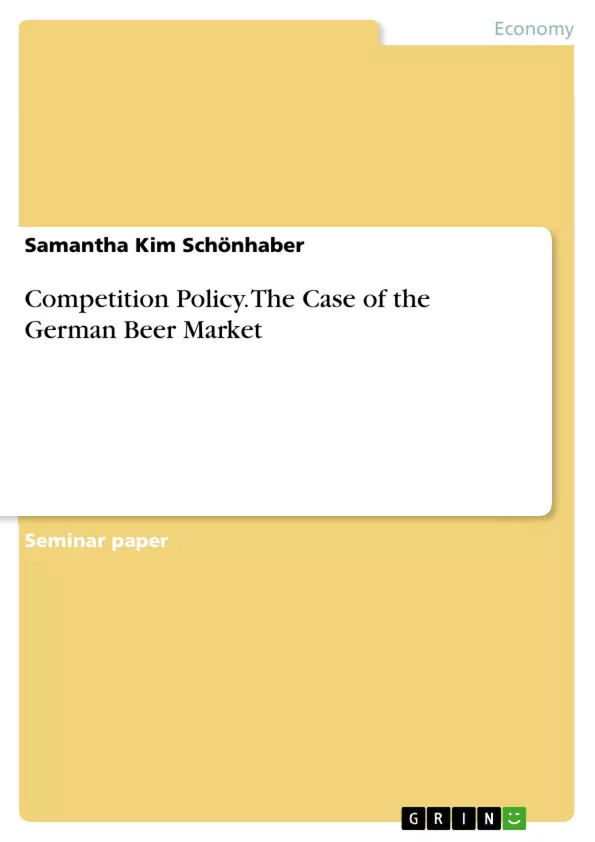This assignment will give an overview on competition policy on the example of the German beer market. This includes the definition of how a price is determined and what the characteristics of a competitive market are. The German beer market will be described as an example of a competitive market. Subsequently the case “Bußgelder gegen Brauereien B10-105/11” investigated by the Bundeskartellamt in 2014 will give a practical example for price agreements.
Competition is a phenomenon in the economy. It is characterized by the existence of markets and at least two suppliers and buyers in competition with each other. The advantageous features of the price mechanism in a competitive market only arise if there is competition between suppliers. Competition does not necessarily exist of its own accord. The core business objective of companies is to generate profits. The less competition there is in the market, the easier this goal can be achieved.
The beer market in Germany is chosen as the example for a competitive market because numerous suppliers offer their products to numerous customers. Last year the number of breweries grew to 1,548 in total. While 20 years ago the number of breweries was 1,281 (1999), it has increased by 267 businesses in the last two decades.With total beer sales of 92 million hectolitres - excluding nonalcoholic beers - Germany continues to be the largest producer of beer in Europe.
Inhaltsverzeichnis (Table of Contents)
- Introduction
- Definition
- Determination of a price
- Characteristics of competitive markets
- Analysis of the German beer market
- Bundeskartellamt
- "Bußgelder gegen Brauereien B10-105/11"
- Conclusion
Zielsetzung und Themenschwerpunkte (Objectives and Key Themes)
This assignment provides an overview of competition policy using the German beer market as an example. It examines how prices are determined and the characteristics of a competitive market. The German beer market serves as a case study for a competitive market. The case "Bußgelder gegen Brauereien B10-105/11" investigated by the Bundeskartellamt in 2014 illustrates a practical example of price agreements.
- Definition and characteristics of a competitive market
- Analysis of the German beer market as an example of a competitive market
- Role of the Bundeskartellamt in regulating competition
- Price agreements in the German beer market
- Impact of competition policy on the German beer market
Zusammenfassung der Kapitel (Chapter Summaries)
- Introduction: This chapter introduces the importance of competition policy and its role in economic and social order. It highlights the significance of rules in maintaining fair competition and the focus of the assignment on the German beer market.
- Definition: This chapter defines how prices are determined in a market and outlines the characteristics of a competitive market. It explores key aspects like the interaction of supply and demand, the presence of numerous buyers and sellers, and the absence of barriers to entry.
- Analysis of the German beer market: This chapter analyzes the German beer market to illustrate the concepts of a competitive market. It examines market trends, competition among brewers, and the role of consumer behavior in shaping the market.
- Bundeskartellamt: This chapter introduces the Bundeskartellamt, the German Federal Cartel Office, and its role in enforcing competition law. It discusses the organization's functions, responsibilities, and its authority to investigate and penalize anti-competitive practices.
- "Bußgelder gegen Brauereien B10-105/11": This chapter focuses on the case "Bußgelder gegen Brauereien B10-105/11" investigated by the Bundeskartellamt in 2014. It analyzes the specific price agreements that were found to violate competition laws and the resulting penalties imposed on the breweries involved.
Schlüsselwörter (Keywords)
Competition policy, German beer market, price determination, competitive market, Bundeskartellamt, price agreements, anti-competitive practices, market regulation, consumer behavior, market trends, brewery industry, hectolitres, Bußgelder, B10-105/11.
- Quote paper
- Samantha Kim Schönhaber (Author), 2020, Competition Policy. The Case of the German Beer Market, Munich, GRIN Verlag, https://www.grin.com/document/919352



